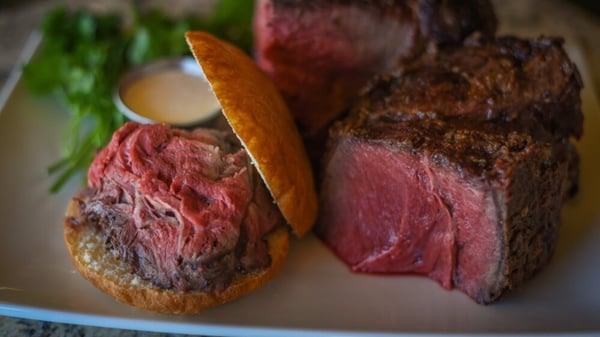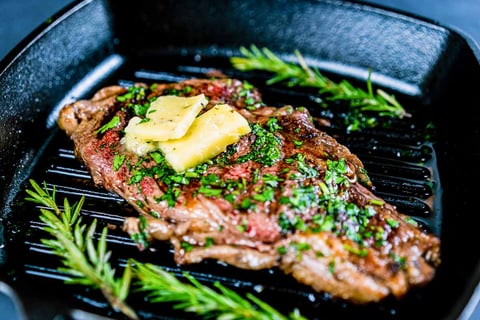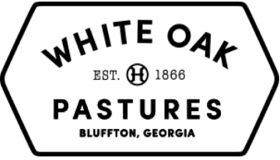One of the best parts of the Regenerative Food Movement is that it binds together people from many walks of life. Whether the focus is on raising livestock, fitness, culinary arts, or health, we are all hungry for the same thing: good, clean food. We are grateful for our new friendship and partnership with Chelsea and Joel at Ultimate Paleo Guide and Ultimate Meal Plans and pleased to share their perspective with our readers.
February is American Heart Month. And while the candy hearts and Valentines are certainly abundant, we’re talking about your actual heart. You know, that organ that’s beating inside of your chest.
American Heart Month was created to raise awareness about heart disease because the reach of the disease is massive. In fact, heart disease is the most prevalent cause of death with its impact touching 1 in 4 people. Chances are you, or someone you know, has been affected by it.
What is heart disease?
Heart disease is a blanket term that covers a variety of conditions including coronary artery disease, heart failure, and heart attacks to name a few. It’s important to have basic knowledge about heart disease because the numbers speak for themselves.
It’s a problem for our nation.
The first step is to know the risk factors. There are many risk factors that contribute to the development of the condition including high blood pressure, high cholesterol, smoking, diabetes, and obesity.
While the numbers are bleak, there is hope! A lot of these risk factors can be improved through....*drum roll, please*...diet and lifestyle change. There is no magic pill - no quick fix. But with some simple, yet impactful, changes, you can drastically decrease your risk.
So, what can you do?
If you Google “diet changes for heart disease”, you’ll find an article from Heart.org outlining their diet recommendations for a heart-healthy diet. The first being - choose a healthy eating plan.
Great! But what does that mean exactly?
As a Nutritionist for Ultimate Paleo Guide, my go-to recommendation is a diet based in whole foods. This means you’re eating foods that are mostly unprocessed with minimal added ingredients. Lots of colorful fruits and vegetables obviously. A well-balanced diet with nutrient-rich foods. Actually, we believe in the power of this type of diet so much that we created an affordable meal plan service to make it as easy as possible for people.

Red Meat and Heart Health
But then we come to the issue of meat. Specifically, Heart.org recommends eating fish and skinless poultry products...and limiting red meat. This is where our opinions diverge.
The issue I have with this recommendation is in regards to red meat. Let me explain…
Research shows that people in the U.S. eat 3 times more meat than the global average. But - the majority of meat that people consume comes from farms that practice industrial agriculture - which can include cramming their animals onto feedlots and force-feeding them grain products. It’s safe to say that conditions in these farming facilities are horrendous.
Conventionally-raised meat is affordable, so it’s relatively easy for people to include it in their diet often. But let’s be honest...you get what you pay for. That meat is of the poorest quality.
So, yes, I completely agree that Americans should not be eating this type of meat. BUT, there is an alternative. Eating pasture-finished meat - like you would get from White Oak Pastures - is a completely different story.
 Grassfed Beef with Tallow Non-Dairy Butter Substitute
Grassfed Beef with Tallow Non-Dairy Butter Substitute
Humanely-raised meat costs more because the quality is HIGH. These animals are raised in the way that nature intended - they can graze and roam. They can eat grass and soak up sunshine. They breed naturally. Their death is dignified. Higher quality means a higher price tag. And unless you’re a millionaire, you won’t buy it in massive qualities - as you might with cheap, conventionally-raised meat.
This, my friends, is a very good thing all around. When you choose to support regenerative agriculture, your consumption of low-quality red meat goes to zero (I believe the American Heart Association would approve!). You support animal welfare. And you’re supporting an organization that is committed to environmental sustainability.
![]() Regenerative agriculture, including holistically-managed livestock, effectively captures soil carbon, offsetting a majority of the emissions related to beef production.
Regenerative agriculture, including holistically-managed livestock, effectively captures soil carbon, offsetting a majority of the emissions related to beef production.
But let’s talk for a minute about the nutritional quality of the two. First off, there’s not a *ton* of research on the topic. This needs to be explored more. But from studies that have been done, we can generally draw the conclusion that pasture-finished meat is richer in nutrients.
In fact, in a 2017 study looking at grass-fed meat and human and environmental health, the study states, “...phytochemical richness of herbivore diets enhances biochemical richness of meat and dairy, which is linked with human and environmental health.”
So, for the sake of your heart health, by all means choose a healthy eating plan! But know that I truly believe a healthy eating plan includes a well-balanced diet with HIGH-QUALITY red meat. Please choose grass-fed and finished meat. The higher price tag is 100% worth the investment.
Not only are you investing in your health, but you’re investing in the health of the animals that nourish us and the Earth that houses us.

Chelsea Brinegar is the Nutritionist and Health Coach for Ultimate Paleo Guide and Ultimate Meal Plans.

